Cleaning a CCD Sensor
You
may find over a period of time, that when you change the lens dust gets
into the CCD surface– whereas small Compact cameras with a single
lens are sealed from the dust. it can be very tricky to clean a DSLR - to get it done professionally costs about $35 – which is the safest and best way – however $35 a clean can as you might put it clean you out of $ |
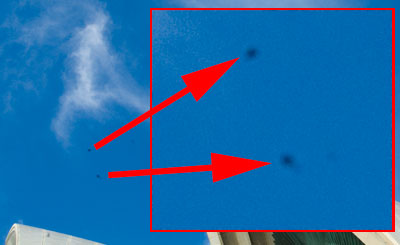 |
As dust tends to fall downwards, If you can change the lens holding the
lens in a lower position than the body – if you have a lens brush
and dust it off just before you change it – you will find you can
reduce the dust problem. On the other had if you hold the body with the
opening facing upwards to place the lens on – you will find there
is more chance of dust falling into the body.
You need a special swab that you can get from a camera shop – if you use other cleaning devices like a normal camels hair blower brush, you can ruin the sensor . Use the swab once and then discard it.
First open the shutter on B and hold it open with the lens off which lets you in to the chamber - do this with new batteries or with the camera plugged into the power - if the shutter closes because the batteries fail you will have a disaster. You need good light so you can see what is happening - and you must only clean the sensor – some cameras have a fine grease around the outside of the ccd and you can end up dragging this onto the sensor .
Swipe the swab along the ccd in a smooth direct action without too much pressure – let it pick up the dust rather than wipe it off
If
you see a black spot in the same spot of the frame on every image then
you will have to get it cleaned. Were it is easy to clean the dust from
the chamber with a film camera, it can be much trickier with digital.
The temptation is to use a brush or a blower brush that works fine for
film cameras. Do not use a brush of any sort to clean the ccd
– usually the bristles are too coarse.
| I
also use a thing tube attached to a vacuum cleaner hose. You can buy special
fittings from an electronics store, like Dick Smith Electronics –
But you can also use some tape to do the same job. The first thing
to remember is the CCD sensor is very delicate and can easily be damaged
which will mean that the damage can show on every image you take.
Around the edge of the sensor is a fine grease which you don not want
to move onto the sensor. |
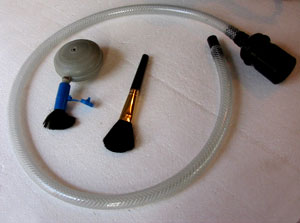 |
Take
the lens off the camera so you can get access to the chamber. You
need to set the camera onto a shutter speed of B or T and leave
it open indefinably, so use a cable release and lock it open. –
you don’t want the shutter to close while the tube is inside. |
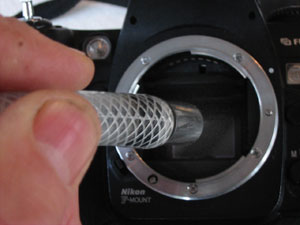 |
Most
manufacturers recommend that you do this with the camera on mains power
as you do not want the shutter to close when the pipe is inside, however
a new set of batteries will do the job.
| Gently
lower the tube down into the chamber but DO NOT touch the CCD sensor
- use good light and make sure there is a gap between the sensor and
the tube. |
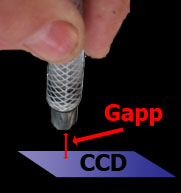
|
This
should suck out any dust. If there is still dust there you may need
to get it cleaned professionally, which can be relatively expensive. |
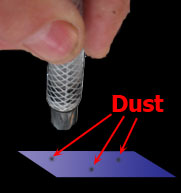
Mouse over |
Let the vacuum do the work – it will remove all the dust except for those particles that are stuck to the sensor – which can only be removed with the swab.
This will also allow you to suck up any dust inside the chamber an on the mirror.
|